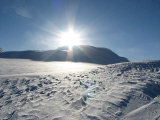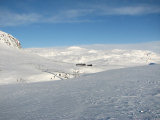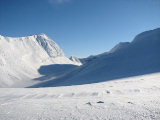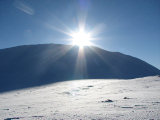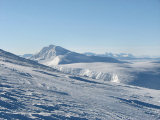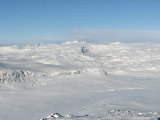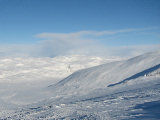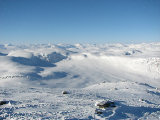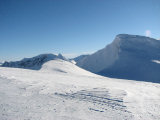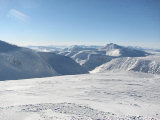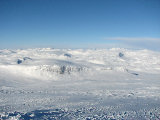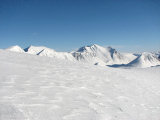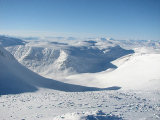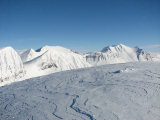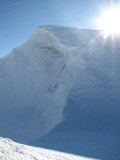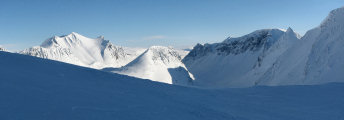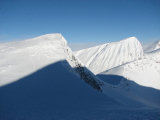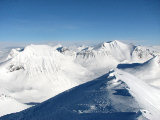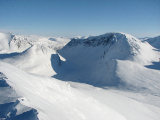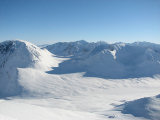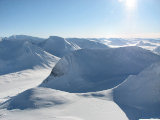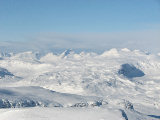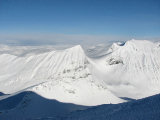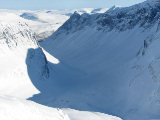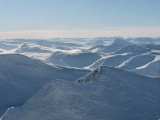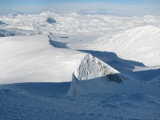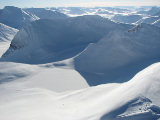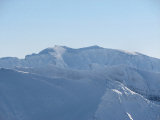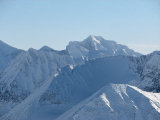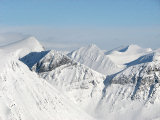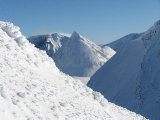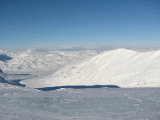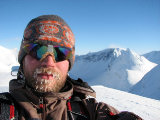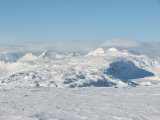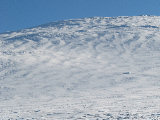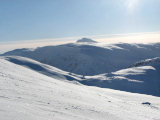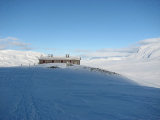Monday 4/3

Čeakčačohkka
| Horizontal distance: | 11 km |
| Vertical distance: | +820 m, -820 m |
| Time: | 4 h 30 min |
| Lunch break: | 45 min |
| Dinner: | – |
| Night accommodation: | – |
| Stage classification: | Hard |
Since the descent would be a long one under somewhat uncertain conditions I had selected the more sturdy telemark equipment this time around, and had the climbing skins on from the start. I aimed straight for Šielmmáčorru's peak at first, and then turned right across the slope, half of the time in shadow, eventually coming up onto the plateau that is the northwestern outrunner from Čeakčačohkka. The next rise looked very steep as it lay there in deep shadow right in front of me, but the closer I got the less intimidating it became, and I ended up going straight up, employing the bindings' risers. The views grew all the time, and once I had cleared the steeper part of the slope I turned towards peak 1677, which was a clear target. The feeling of altitude was strong, and as I neared the summit the higher and more jagged shapes behind it appeared to great effect.
The main rise of Čeakčačohkka, peaking at 1820 m, was the feature of most interest to me, and from this distance and angle it looked absolutely doable; it was a perfect day, with very little wind, so I went on to the next rise just above the glacier pass between the heights, keeping my distance to what I judged was a substantial cornice. After a pause I left my skis at the smaller summit and walked down the slope, again a good distance from the edge to the glacier. Some of the snow was of the cauliflower variety, but between that it was very nice, and I could have had a lot of fun in this area with my purpose-appropriate equipment if I hadn't had a specific goal in mind. Once I entered the shadow a wind picked up and things grew chilly, and a short distance up the next slope the snow grew softer, which made for heavy plodding. After a steeper part with much harder snow necessitating some "grip kicks" I came up into the sun once more, and the remainder of the way was a simple walk from the west.
I covered the last bit carefully, since this peak is usually subjected to severe drift, and people have perished from misjudging the snow. This time, however, I had seen from below that the cornice that often extends all the way up to the summit was virtually nonexistent at the moment – at least in the upper parts – so I felt confident about where I could safely step. I stood at the top precisely at noon – earlier than expected, given how taxing the last ascent had been – and promptly set about photographing. This peak is eminently situated, and offers stupendous views in all directions – especially on a day such as this. Wow indeed. I had lunch in an appreciable but manageable wind, looking at the northern clouds which were slowly approaching, darkening as they did so – but they were still far enough away so as not to warrant worry.
On the way down I kept closer to the edge, since I had seen from the top that there was no overhang there, and here the snow was better. Further down I came upon my own tracks, and followed them back up to the skis, and after putting them on I made my way over to 1677 where I paused for a bit. I had considered the option of telemarking down the valley between 1677 and 1820, coming down near the Tjäktja Pass shelter, which would certainly have been good snow and skiing wise, but I decided to go for the physically lighter alternative and simply backtrack all the way.
So, then it was time for downhill mode, and the first bit down to the steeper slope was actually better than expected; there was certainly no powder, but neither was there a breaking crust, so it was quite alright. The following slope was also good, in the same way, and I let myself get into it a bit more. After that I checked out the western slope of the outrunner, selecting portions that looked softer, gliding the last bit down to the bridge. I skied over to the buildings in the last rays of the sun around 14:15, noting two pairs of skis outside.
« Return to Tjäktja report
